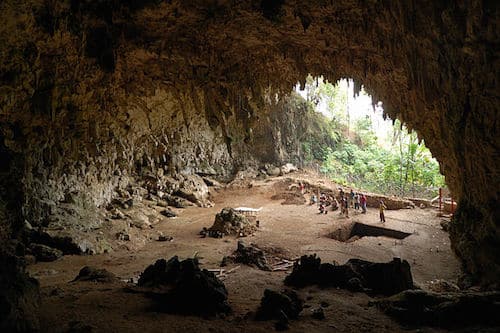 Evolution
Evolution
 Human Origins
Human Origins
The Little Lady of Flores Spoke from the Grave. But Said What, Exactly?

If Darwinian evolution is true, the human race should evolve into different species. Indeed, Darwin said that in Descent of Man. It is a feature, not a bug. But there is no clear evidence that it is happening. Thus, it would be most helpful to the argument if a new species (i.e., clearly human but not homo sapiens) was unearthed. Or at least, if the evidence was mixed, a species that could be argued into existence.
 In 2003, an international archeology team was excavating the Liang Bua limestone cave (pictured above) on the Indonesian island of Flores, between Sumatra and East Timor. At a six meters depth, they unearthed the skeleton of a tiny ancient woman, about thirty years old. She was a meter in height (a little over a yard), with the brain capacity of a small chimpanzee.
In 2003, an international archeology team was excavating the Liang Bua limestone cave (pictured above) on the Indonesian island of Flores, between Sumatra and East Timor. At a six meters depth, they unearthed the skeleton of a tiny ancient woman, about thirty years old. She was a meter in height (a little over a yard), with the brain capacity of a small chimpanzee.
When the discovery was announced in October 2004, the buzz was that she represented a new human species. As such, she was “extreme,” “spectacular,” “startling,” and “incredible.” The Return of the King was released that year, so she was dubbed the “hobbit.”
One researcher hoped that a “male” would turn up. His wish was swiftly granted — by a National Geographic artist who offered an imaginative drawing of a “male” returning from the hunt, looking impressively feral, and distinctly other than human. By August 2007, Science was calling the dig “hallowed ground.” In that year, modern humans were predictably fingered as the villains that wiped out Flores man. In addition, the find answered another unmet need: To Henry Gee, writing in Nature, it posed “thorny questions about the uniqueness of Homo sapiens.”
The cave turned up more than bones; it revealed stone tools, remains of fires, and the bones of pygmy elephants and other feasts. So the hobbit woman and the other individuals later unearthed — the oldest dating from perhaps 94,000 years ago — apparently followed the same lifestyle as other ancient human groups. But then how did we decide that they were not just one of the vast variety of human types?
The key fossil’s small brain was taken by many researchers as evidence that the Floresians must be a separate species. That and an odd-shaped wrist bone. But almost immediately, a competing narrative appeared. In November, leading Indonesian scientist Teuku Jacob (1929-2007) announced that the Flores hobbit was an “ordinary human” and “just like us,” but possibly with mental defects. Jacob took the bones to his own lab, and returned most of them the following February, amid charges that he had severely damaged them.
He also damaged the orthodox narrative. And Nature wasn’t having any of that “just like us” stuff. In March 2005, it triumphantly reported the results of a computer simulation that bolstered the new species claim, in a story titled “Critics silenced by scans of hobbit skull.” But the critics’ silence did not dispel lingering doubt about “Homo floresiensis.”
Concern was raised that the ongoing controversy might be good for creationism. One researcher offered that “we certainly make it easy for them when we have disagreements like this one. I think that a lot of what has been said is going to have to be retracted. Given the amount of media attention, it just makes the field look incompetent.” He concluded: “Nobody is on the side of the angels now.”
Not even the angels, it seemed.
By March 2008, the scene had changed again. New Scientist told us, “Researchers have uncovered bones that could drive another nail into the Homo floresiensis coffin.” The magazine’s nail-and-coffin metaphor is a signal: Doubt is now fashionable, not forbidden. Why? Apparently, diminutive humans had “overrun” a nearby island as recently as 1400 years ago — “but despite their size these people clearly belonged to our species.”
Meanwhile, more recent reconstructions have suggested that Flores man looked like us, and that earlier artists’ reconstructions may have distorted this fact:
Basically, chimps don’t have human cheeks, the study argues, so past reconstructions of the hobbit’s face botched its likely looks. Or past efforts fell into the trap of assuming all early modern human species resembled “wild men,” “missing links” or “ape-men.”
And on it goes. The old bones told no new tale.
To get a sense of the breadth of positions in the controversy, see “Is the Hobbit’s Brain Unfeasibly Small?” (maybe not); “Compelling Evidence Demonstrates that ‘Hobbit’ Fossil Does Not Represent A New Species of Hominid”; “Researchers offer alternate theory for found skull’s asymmetry” (malformed individual); “‘Hobbit’ Was an Iodine-Deficient Human, Not Another Species, New Study Suggests.”
Meanwhile, the Neanderthals were becoming ever more dissatisfied with their treatment at the hands of taxonomists.
Editor’s note: Here are links to the whole “Science Fictions: Human Evolution” series to date.
